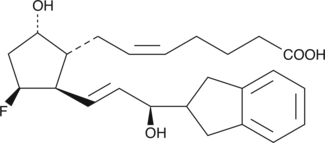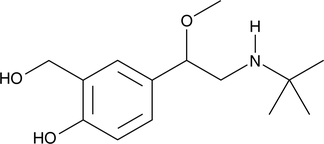Chemicals
Showing 8701–8850 of 41137 results
-
AKB48 (Item No. ISO00060) is a pentyl indazole with structural similarity to the synthetic cannabinoids, JWH 018 adamantyl carboxamide (Item No. 9001193) and STS-135 (Item No. 11564).{22837} AKB48 N-(5-hyroxypentyl) metabolite is a potential urinary metabolite of AKB48, characterized by monohydroxylation of the N-alkyl chain.{18291} This product is intended for research and forensic applications.
Brand:CaymanSKU:-AKB48 (Item No. ISO00060) is a pentyl indazole with structural similarity to the synthetic cannabinoids, JWH 018 adamantyl carboxamide (Item No. 9001193) and STS-135 (Item No. 11564).{22837} AKB48 N-(5-hyroxypentyl) metabolite is a potential urinary metabolite of AKB48, characterized by monohydroxylation of the N-alkyl chain.{18291} This product is intended for research and forensic applications.
Brand:CaymanSKU:-AKB48 (Item No. ISO00060) is a pentyl indazole with structural similarity to the synthetic cannabinoids, JWH 018 adamantyl carboxamide (Item No. 9001193) and STS-135 (Item No. 11564).{22837} AKB48 N-(5-hyroxypentyl) metabolite is a potential urinary metabolite of AKB48, characterized by monohydroxylation of the N-alkyl chain.{18291} This product is intended for research and forensic applications.
Brand:CaymanSKU:-AKB48 (Item No. ISO00060) is a pentyl indazole with structural similarity to JWH 018 adamantyl carboxamide (Item No. 9001193) and STS-135 (Item No. 11564), which are synthetic cannabinoids that may be sold for recreational use.{22837} AKB48 N-pentantoic acid metabolite is a potential urinary metabolite of AKB48, characterized by carboxylation of the N-alkyl chain.{18291} This product is intended for research and forensic applications.
Brand:CaymanSKU:-AKB48 (Item No. ISO00060) is a pentyl indazole with structural similarity to JWH 018 adamantyl carboxamide (Item No. 9001193) and STS-135 (Item No. 11564), which are synthetic cannabinoids that may be sold for recreational use.{22837} AKB48 N-pentantoic acid metabolite is a potential urinary metabolite of AKB48, characterized by carboxylation of the N-alkyl chain.{18291} This product is intended for research and forensic applications.
Brand:CaymanSKU:-AKB48 (Item No. ISO00060) is a pentyl indazole with structural similarity to JWH 018 adamantyl carboxamide (Item No. 9001193) and STS-135 (Item No. 11564), which are synthetic cannabinoids that may be sold for recreational use.{22837} AKB48 N-pentantoic acid metabolite is a potential urinary metabolite of AKB48, characterized by carboxylation of the N-alkyl chain.{18291} This product is intended for research and forensic applications.
Brand:CaymanSKU:-AKP-11 is an agonist of sphingosine-1-phosphate receptor 1 (S1P1) with an EC50 value of 0.047 μM for [35S]GTPγS binding to CHO-K1 cell membranes expressing the human receptor.{53138} It decreases surface expression of S1P1 and increases phosphorylation of Akt and ERK in CHO cells expressing S1P1-HA when used at a concentration of 100 nM.{53139} AKP-11 (1.3 and 3 mg/kg) reduces protein levels of IFN-γ and IL-17 in spinal cord tissue and decreases disease severity in a rat model of experimental autoimmune encephalomyelitis (EAE). It decreases peripheral counts of total lymphocytes and total, CD4+, CD8+, and CD26L+ T cells in an EAE rat model, as well as in healthy control animals, when administered at a dose of 1.3 mg/kg.
Brand:CaymanSKU:27670 - 1 mgAvailable on backorder
AKP-11 is an agonist of sphingosine-1-phosphate receptor 1 (S1P1) with an EC50 value of 0.047 μM for [35S]GTPγS binding to CHO-K1 cell membranes expressing the human receptor.{53138} It decreases surface expression of S1P1 and increases phosphorylation of Akt and ERK in CHO cells expressing S1P1-HA when used at a concentration of 100 nM.{53139} AKP-11 (1.3 and 3 mg/kg) reduces protein levels of IFN-γ and IL-17 in spinal cord tissue and decreases disease severity in a rat model of experimental autoimmune encephalomyelitis (EAE). It decreases peripheral counts of total lymphocytes and total, CD4+, CD8+, and CD26L+ T cells in an EAE rat model, as well as in healthy control animals, when administered at a dose of 1.3 mg/kg.
Brand:CaymanSKU:27670 - 10 mgAvailable on backorder
AKP-11 is an agonist of sphingosine-1-phosphate receptor 1 (S1P1) with an EC50 value of 0.047 μM for [35S]GTPγS binding to CHO-K1 cell membranes expressing the human receptor.{53138} It decreases surface expression of S1P1 and increases phosphorylation of Akt and ERK in CHO cells expressing S1P1-HA when used at a concentration of 100 nM.{53139} AKP-11 (1.3 and 3 mg/kg) reduces protein levels of IFN-γ and IL-17 in spinal cord tissue and decreases disease severity in a rat model of experimental autoimmune encephalomyelitis (EAE). It decreases peripheral counts of total lymphocytes and total, CD4+, CD8+, and CD26L+ T cells in an EAE rat model, as well as in healthy control animals, when administered at a dose of 1.3 mg/kg.
Brand:CaymanSKU:27670 - 25 mgAvailable on backorder
AKP-11 is an agonist of sphingosine-1-phosphate receptor 1 (S1P1) with an EC50 value of 0.047 μM for [35S]GTPγS binding to CHO-K1 cell membranes expressing the human receptor.{53138} It decreases surface expression of S1P1 and increases phosphorylation of Akt and ERK in CHO cells expressing S1P1-HA when used at a concentration of 100 nM.{53139} AKP-11 (1.3 and 3 mg/kg) reduces protein levels of IFN-γ and IL-17 in spinal cord tissue and decreases disease severity in a rat model of experimental autoimmune encephalomyelitis (EAE). It decreases peripheral counts of total lymphocytes and total, CD4+, CD8+, and CD26L+ T cells in an EAE rat model, as well as in healthy control animals, when administered at a dose of 1.3 mg/kg.
Brand:CaymanSKU:27670 - 5 mgAvailable on backorder
Akt inhibitor IV is an inhibitor of Akt activation that inhibits Akt-mediated nuclear export of Forkhead box class O transcription factor 1a (FOXO1a; IC50 = 625 nM) and reduces phosphorylation of Akt at Ser473 and Thr308 in a dose-dependent manner.{36268} Akt inhibitor IV inhibits replication of parainfluenza virus 5 (PIV5) in HeLa cells (IC50 = 520 nM).{36269} It also reduces the growth of cancer cells (IC50 = 0.3 μM for both Jurkat and HeLa cells) via a reduction in mitochondrial polarization and increased production of reactive oxygen species (ROS).{36270}
Brand:CaymanSKU:-Akt inhibitor IV is an inhibitor of Akt activation that inhibits Akt-mediated nuclear export of Forkhead box class O transcription factor 1a (FOXO1a; IC50 = 625 nM) and reduces phosphorylation of Akt at Ser473 and Thr308 in a dose-dependent manner.{36268} Akt inhibitor IV inhibits replication of parainfluenza virus 5 (PIV5) in HeLa cells (IC50 = 520 nM).{36269} It also reduces the growth of cancer cells (IC50 = 0.3 μM for both Jurkat and HeLa cells) via a reduction in mitochondrial polarization and increased production of reactive oxygen species (ROS).{36270}
Brand:CaymanSKU:-Akt inhibitor IV is an inhibitor of Akt activation that inhibits Akt-mediated nuclear export of Forkhead box class O transcription factor 1a (FOXO1a; IC50 = 625 nM) and reduces phosphorylation of Akt at Ser473 and Thr308 in a dose-dependent manner.{36268} Akt inhibitor IV inhibits replication of parainfluenza virus 5 (PIV5) in HeLa cells (IC50 = 520 nM).{36269} It also reduces the growth of cancer cells (IC50 = 0.3 μM for both Jurkat and HeLa cells) via a reduction in mitochondrial polarization and increased production of reactive oxygen species (ROS).{36270}
Brand:CaymanSKU:-Akt inhibitor IV is an inhibitor of Akt activation that inhibits Akt-mediated nuclear export of Forkhead box class O transcription factor 1a (FOXO1a; IC50 = 625 nM) and reduces phosphorylation of Akt at Ser473 and Thr308 in a dose-dependent manner.{36268} Akt inhibitor IV inhibits replication of parainfluenza virus 5 (PIV5) in HeLa cells (IC50 = 520 nM).{36269} It also reduces the growth of cancer cells (IC50 = 0.3 μM for both Jurkat and HeLa cells) via a reduction in mitochondrial polarization and increased production of reactive oxygen species (ROS).{36270}
Brand:CaymanSKU:-Akt inhibitor VIII is a potent allosteric inhibitor of Akt1 and Akt2 (IC50s = 58 and 210 nM, respectively) that less effectively blocks Akt3 activity (IC50 = 2.2 µM).{24205,24204,24208} It is a poor or ineffective inhibitor of a wide range of other serine-threonine kinases.{24203} Akt inhibitor VIII is cell permeable, blocking insulin regulation of forkhead box 01 activity at 1 µM in rat hepatoma cells.{24203}
Brand:CaymanSKU:-Akt inhibitor VIII is a potent allosteric inhibitor of Akt1 and Akt2 (IC50s = 58 and 210 nM, respectively) that less effectively blocks Akt3 activity (IC50 = 2.2 µM).{24205,24204,24208} It is a poor or ineffective inhibitor of a wide range of other serine-threonine kinases.{24203} Akt inhibitor VIII is cell permeable, blocking insulin regulation of forkhead box 01 activity at 1 µM in rat hepatoma cells.{24203}
Brand:CaymanSKU:-Akt inhibitor VIII is a potent allosteric inhibitor of Akt1 and Akt2 (IC50s = 58 and 210 nM, respectively) that less effectively blocks Akt3 activity (IC50 = 2.2 µM).{24205,24204,24208} It is a poor or ineffective inhibitor of a wide range of other serine-threonine kinases.{24203} Akt inhibitor VIII is cell permeable, blocking insulin regulation of forkhead box 01 activity at 1 µM in rat hepatoma cells.{24203}
Brand:CaymanSKU:-Akt inhibitor VIII is a potent allosteric inhibitor of Akt1 and Akt2 (IC50s = 58 and 210 nM, respectively) that less effectively blocks Akt3 activity (IC50 = 2.2 µM).{24205,24204,24208} It is a poor or ineffective inhibitor of a wide range of other serine-threonine kinases.{24203} Akt inhibitor VIII is cell permeable, blocking insulin regulation of forkhead box 01 activity at 1 µM in rat hepatoma cells.{24203}
Brand:CaymanSKU:-Akt functions as a key component in multiple signaling pathways to promote cell survival by mediating resistance to apoptosis. Akt inhibitor X is a cell permeable phenoxazine derivative that suppresses insulin-like growth factor 1 (IGF-1)-stimulated phosphorylation of Akt with an IC50 value of 1-2 μM.{23567} This compound has been shown to block IGF-1-stimulated nuclear translocation of Akt in Rh1 cells and to inhibit the growth of Rh1, Rh18, and Rh30 cells with IC50 values of 2-5 μM.{23567} Inhibition of Akt phosphorylation by 5 μM of this compound strongly correlates to the inhibition of the downstream targets, mTOR, p70S6 kinase, and S6 ribosomal protein and to an increase in apoptosis.{23567}
Brand:CaymanSKU:-Akt functions as a key component in multiple signaling pathways to promote cell survival by mediating resistance to apoptosis. Akt inhibitor X is a cell permeable phenoxazine derivative that suppresses insulin-like growth factor 1 (IGF-1)-stimulated phosphorylation of Akt with an IC50 value of 1-2 μM.{23567} This compound has been shown to block IGF-1-stimulated nuclear translocation of Akt in Rh1 cells and to inhibit the growth of Rh1, Rh18, and Rh30 cells with IC50 values of 2-5 μM.{23567} Inhibition of Akt phosphorylation by 5 μM of this compound strongly correlates to the inhibition of the downstream targets, mTOR, p70S6 kinase, and S6 ribosomal protein and to an increase in apoptosis.{23567}
Brand:CaymanSKU:-Akt functions as a key component in multiple signaling pathways to promote cell survival by mediating resistance to apoptosis. Akt inhibitor X is a cell permeable phenoxazine derivative that suppresses insulin-like growth factor 1 (IGF-1)-stimulated phosphorylation of Akt with an IC50 value of 1-2 μM.{23567} This compound has been shown to block IGF-1-stimulated nuclear translocation of Akt in Rh1 cells and to inhibit the growth of Rh1, Rh18, and Rh30 cells with IC50 values of 2-5 μM.{23567} Inhibition of Akt phosphorylation by 5 μM of this compound strongly correlates to the inhibition of the downstream targets, mTOR, p70S6 kinase, and S6 ribosomal protein and to an increase in apoptosis.{23567}
Brand:CaymanSKU:-Akt functions as a key component in multiple signaling pathways to promote cell survival by mediating resistance to apoptosis. Akt inhibitor X is a cell permeable phenoxazine derivative that suppresses insulin-like growth factor 1 (IGF-1)-stimulated phosphorylation of Akt with an IC50 value of 1-2 μM.{23567} This compound has been shown to block IGF-1-stimulated nuclear translocation of Akt in Rh1 cells and to inhibit the growth of Rh1, Rh18, and Rh30 cells with IC50 values of 2-5 μM.{23567} Inhibition of Akt phosphorylation by 5 μM of this compound strongly correlates to the inhibition of the downstream targets, mTOR, p70S6 kinase, and S6 ribosomal protein and to an increase in apoptosis.{23567}
Brand:CaymanSKU:-The kinase Akt (also known as protein kinase B or PKB) modulates cell proliferation, metabolism, and survival, as well as angiogenesis.{15560,16917} Akt inhibitor XI is a cell-permeable, copper-containing 3-formylchromone derivative that inhibits Akt in an array of cancer cells (IC50s = 10-34 µM).{30190} It also causes NF-κB inactivation in an orthotopic pancreatic tumor model using COLO 357 cells.{30190} Molecular modeling indicates that this inhibitor interacts with the pleckstrin homology and kinase domains of Akt. Akt inhibitor XI is commonly used in the range of 1-20 µM to assess the role of Akt in cellular responses.{30191,30192,30193}
Brand:CaymanSKU:-Available on backorder
The kinase Akt (also known as protein kinase B or PKB) modulates cell proliferation, metabolism, and survival, as well as angiogenesis.{15560,16917} Akt inhibitor XI is a cell-permeable, copper-containing 3-formylchromone derivative that inhibits Akt in an array of cancer cells (IC50s = 10-34 µM).{30190} It also causes NF-κB inactivation in an orthotopic pancreatic tumor model using COLO 357 cells.{30190} Molecular modeling indicates that this inhibitor interacts with the pleckstrin homology and kinase domains of Akt. Akt inhibitor XI is commonly used in the range of 1-20 µM to assess the role of Akt in cellular responses.{30191,30192,30193}
Brand:CaymanSKU:-Available on backorder
The kinase Akt (also known as protein kinase B or PKB) modulates cell proliferation, metabolism, and survival, as well as angiogenesis.{15560,16917} Akt inhibitor XI is a cell-permeable, copper-containing 3-formylchromone derivative that inhibits Akt in an array of cancer cells (IC50s = 10-34 µM).{30190} It also causes NF-κB inactivation in an orthotopic pancreatic tumor model using COLO 357 cells.{30190} Molecular modeling indicates that this inhibitor interacts with the pleckstrin homology and kinase domains of Akt. Akt inhibitor XI is commonly used in the range of 1-20 µM to assess the role of Akt in cellular responses.{30191,30192,30193}
Brand:CaymanSKU:-Available on backorder
The kinase Akt (also known as protein kinase B or PKB) modulates cell proliferation, metabolism, and survival, as well as angiogenesis.{15560,16917} Akt inhibitor XI is a cell-permeable, copper-containing 3-formylchromone derivative that inhibits Akt in an array of cancer cells (IC50s = 10-34 µM).{30190} It also causes NF-κB inactivation in an orthotopic pancreatic tumor model using COLO 357 cells.{30190} Molecular modeling indicates that this inhibitor interacts with the pleckstrin homology and kinase domains of Akt. Akt inhibitor XI is commonly used in the range of 1-20 µM to assess the role of Akt in cellular responses.{30191,30192,30193}
Brand:CaymanSKU:-Available on backorder
AL 082D06 is a non-steroidal antagonist of the glucocorticoid receptor (GR; Ki = 210 nM; EC50 = 0.3 nM in a luciferase assay).{36271} It is selective for GR over the androgen, progesterone, mineralocorticoid, and estrogen receptors with Ki values greater than 4, 3, 3, and 10 µM, respectively. AL 082D06 inhibits transcriptional activation induced by glucocorticoids and reverses dexamethasone-mediated repression of gene expression in a luciferase reporter assay. It blocks GR binding to DNA in vitro when induced by either dexamethasone (Item No. 11015) or mifepristone (Item No. 10006317). In contrast to the steroid-type GR antagonists ZK-299 and mifepristone, GR bound to AL 082D06 does not compete with a constitutively active GR.
Brand:CaymanSKU:23455 - 1 mgAvailable on backorder
AL 082D06 is a non-steroidal antagonist of the glucocorticoid receptor (GR; Ki = 210 nM; EC50 = 0.3 nM in a luciferase assay).{36271} It is selective for GR over the androgen, progesterone, mineralocorticoid, and estrogen receptors with Ki values greater than 4, 3, 3, and 10 µM, respectively. AL 082D06 inhibits transcriptional activation induced by glucocorticoids and reverses dexamethasone-mediated repression of gene expression in a luciferase reporter assay. It blocks GR binding to DNA in vitro when induced by either dexamethasone (Item No. 11015) or mifepristone (Item No. 10006317). In contrast to the steroid-type GR antagonists ZK-299 and mifepristone, GR bound to AL 082D06 does not compete with a constitutively active GR.
Brand:CaymanSKU:23455 - 10 mgAvailable on backorder
AL 082D06 is a non-steroidal antagonist of the glucocorticoid receptor (GR; Ki = 210 nM; EC50 = 0.3 nM in a luciferase assay).{36271} It is selective for GR over the androgen, progesterone, mineralocorticoid, and estrogen receptors with Ki values greater than 4, 3, 3, and 10 µM, respectively. AL 082D06 inhibits transcriptional activation induced by glucocorticoids and reverses dexamethasone-mediated repression of gene expression in a luciferase reporter assay. It blocks GR binding to DNA in vitro when induced by either dexamethasone (Item No. 11015) or mifepristone (Item No. 10006317). In contrast to the steroid-type GR antagonists ZK-299 and mifepristone, GR bound to AL 082D06 does not compete with a constitutively active GR.
Brand:CaymanSKU:23455 - 5 mgAvailable on backorder
The transduction of neurobehavioral effects by serotonin (5-hydroxy tryptamine; 5-HT) is mediated via at least six major 5-HT receptor subtypes, including 5-HT2 AL 34662 is a potent 5-HT2 receptor agonist with ocular hypotensive activity. It binds to the human and rat 5-HT2 receptors in cerebral cortex homogenates with IC50 values of 1.5 and 0.77 nM, respectively.{15497} AL 34662 binds to the recombinant human 5-HT2A, 5-HT2B, and 5-HT2C receptors with IC50 values of 14.5, 8.1, and 3 nM, respectively. In ocular hypertensive cynomolgus monkey eyes, AL 34662 lowered intraocular pressure (IOP) 25% at a dose of 100 µg and 33% at 300 µg (six hours post dose) with minimal side effects.{15497}
Brand:CaymanSKU:10011546 - 1 mgAvailable on backorder
The transduction of neurobehavioral effects by serotonin (5-hydroxy tryptamine; 5-HT) is mediated via at least six major 5-HT receptor subtypes, including 5-HT2 AL 34662 is a potent 5-HT2 receptor agonist with ocular hypotensive activity. It binds to the human and rat 5-HT2 receptors in cerebral cortex homogenates with IC50 values of 1.5 and 0.77 nM, respectively.{15497} AL 34662 binds to the recombinant human 5-HT2A, 5-HT2B, and 5-HT2C receptors with IC50 values of 14.5, 8.1, and 3 nM, respectively. In ocular hypertensive cynomolgus monkey eyes, AL 34662 lowered intraocular pressure (IOP) 25% at a dose of 100 µg and 33% at 300 µg (six hours post dose) with minimal side effects.{15497}
Brand:CaymanSKU:10011546 - 10 mgAvailable on backorder
The transduction of neurobehavioral effects by serotonin (5-hydroxy tryptamine; 5-HT) is mediated via at least six major 5-HT receptor subtypes, including 5-HT2 AL 34662 is a potent 5-HT2 receptor agonist with ocular hypotensive activity. It binds to the human and rat 5-HT2 receptors in cerebral cortex homogenates with IC50 values of 1.5 and 0.77 nM, respectively.{15497} AL 34662 binds to the recombinant human 5-HT2A, 5-HT2B, and 5-HT2C receptors with IC50 values of 14.5, 8.1, and 3 nM, respectively. In ocular hypertensive cynomolgus monkey eyes, AL 34662 lowered intraocular pressure (IOP) 25% at a dose of 100 µg and 33% at 300 µg (six hours post dose) with minimal side effects.{15497}
Brand:CaymanSKU:10011546 - 5 mgAvailable on backorder
The transduction of neurobehavioral effects by serotonin (5-hydroxy tryptamine; 5-HT) is mediated via at least six major 5-HT receptor subtypes, including 5-HT2 AL 34662 is a potent 5-HT2 receptor agonist with ocular hypotensive activity. It binds to the human and rat 5-HT2 receptors in cerebral cortex homogenates with IC50 values of 1.5 and 0.77 nM, respectively.{15497} AL 34662 binds to the recombinant human 5-HT2A, 5-HT2B, and 5-HT2C receptors with IC50 values of 14.5, 8.1, and 3 nM, respectively. In ocular hypertensive cynomolgus monkey eyes, AL 34662 lowered intraocular pressure (IOP) 25% at a dose of 100 µg and 33% at 300 µg (six hours post dose) with minimal side effects.{15497}
Brand:CaymanSKU:10011546 - 50 mgAvailable on backorder
Elevated intraocular pressure (IOP) is an important risk factor in developing glaucoma. Certain prostaglandins such as PGF2α and PGD2, have been shown to reduce IOP. AL 6598 is the isopropyl ester prodrug of AL 6556, a PGD2 receptor agonist that binds to DP receptors with a Ki value of 3.2 µM and demonstrates an EC50 value of 0.80 µM in an in vitro functional assay.{9839} Designed to enhance corneal absorption, AL 6598 produces a maximum 53% drop in IOP of the ocular hypertensive monkey with a 1 µg dose given twice daily.{9839}
Brand:CaymanSKU:-Elevated intraocular pressure (IOP) is an important risk factor in developing glaucoma. Certain prostaglandins such as PGF2α and PGD2, have been shown to reduce IOP. AL 6598 is the isopropyl ester prodrug of AL 6556, a PGD2 receptor agonist that binds to DP receptors with a Ki value of 3.2 µM and demonstrates an EC50 value of 0.80 µM in an in vitro functional assay.{9839} Designed to enhance corneal absorption, AL 6598 produces a maximum 53% drop in IOP of the ocular hypertensive monkey with a 1 µg dose given twice daily.{9839}
Brand:CaymanSKU:-Elevated intraocular pressure (IOP) is an important risk factor in developing glaucoma. Certain prostaglandins such as PGF2α and PGD2, have been shown to reduce IOP. AL 6598 is the isopropyl ester prodrug of AL 6556, a PGD2 receptor agonist that binds to DP receptors with a Ki value of 3.2 µM and demonstrates an EC50 value of 0.80 µM in an in vitro functional assay.{9839} Designed to enhance corneal absorption, AL 6598 produces a maximum 53% drop in IOP of the ocular hypertensive monkey with a 1 µg dose given twice daily.{9839}
Brand:CaymanSKU:-Elevated intraocular pressure (IOP) is an important risk factor in developing glaucoma. Certain prostaglandins such as PGF2α and PGD2, have been shown to reduce IOP. AL 6598 is the isopropyl ester prodrug of AL 6556, a PGD2 receptor agonist that binds to DP receptors with a Ki value of 3.2 µM and demonstrates an EC50 value of 0.80 µM in an in vitro functional assay.{9839} Designed to enhance corneal absorption, AL 6598 produces a maximum 53% drop in IOP of the ocular hypertensive monkey with a 1 µg dose given twice daily.{9839}
Brand:CaymanSKU:-AL 8810 is an 11β-fluoro analog of PGF2α which acts as a potent and selective antagonist at the FP receptor.{7398} AL 8810 has weak intrinsic agonist activity on FP receptor preparations in the 200-300 nM range, yet it fully antagonizes the activity of the potent FP receptor agonist fluprostenol at this concentration, with EC50 values of approximately 430 nM. AL 8810 fully antagonized the bimatoprost-induced calcium mobilization in Swiss 3T3 fibroblasts at 100 µM, indicating that bimatoprost acts as an FP agonist in this preparation.{9581} The Ki for the inhibition of several potent agonists at the cloned human ciliary body FP receptor is in the range of 1-2 µM.{10426}
Brand:CaymanSKU:-Out of stock
AL 8810 is an 11β-fluoro analog of PGF2α which acts as a potent and selective antagonist at the FP receptor.{7398} AL 8810 has weak intrinsic agonist activity on FP receptor preparations in the 200-300 nM range, yet it fully antagonizes the activity of the potent FP receptor agonist fluprostenol at this concentration, with EC50 values of approximately 430 nM. AL 8810 fully antagonized the bimatoprost-induced calcium mobilization in Swiss 3T3 fibroblasts at 100 µM, indicating that bimatoprost acts as an FP agonist in this preparation.{9581} The Ki for the inhibition of several potent agonists at the cloned human ciliary body FP receptor is in the range of 1-2 µM.{10426}
Brand:CaymanSKU:-Out of stock
AL 8810 is an 11β-fluoro analog of PGF2α which acts as a potent and selective antagonist at the FP receptor.{7398} AL 8810 has weak intrinsic agonist activity on FP receptor preparations in the 200-300 nM range, yet it fully antagonizes the activity of the potent FP receptor agonist fluprostenol at this concentration, with EC50 values of approximately 430 nM. AL 8810 fully antagonized the bimatoprost-induced calcium mobilization in Swiss 3T3 fibroblasts at 100 µM, indicating that bimatoprost acts as an FP agonist in this preparation.{9581} The Ki for the inhibition of several potent agonists at the cloned human ciliary body FP receptor is in the range of 1-2 µM.{10426}
Brand:CaymanSKU:-Out of stock
AL 8810 is an 11β-fluoro analog of PGF2α which acts as a potent and selective antagonist at the FP receptor.{7398} AL 8810 has weak intrinsic agonist activity on FP receptor preparations in the 200-300 nM range, yet it fully antagonizes the activity of the potent FP receptor agonist fluprostenol at this concentration, with EC50 values of approximately 430 nM. AL 8810 fully antagonized the bimatoprost-induced calcium mobilization in Swiss 3T3 fibroblasts at 100 µM, indicating that bimatoprost acts as an FP agonist in this preparation.{9581} The Ki for the inhibition of several potent agonists at the cloned human ciliary body FP receptor is in the range of 1-2 µM.{10426}
Brand:CaymanSKU:-Out of stock
AL 8810 (Item No. 16735) is an 11β-fluoro analog of prostaglandin F2α (Item No. 16010) which acts as a potent and selective antagonist at the FP receptor.{7398} AL 8810 isopropyl ester is a lipid soluble, esterified prodrug form of AL 8810 analogous to the commonly used therapeutic intraocular prostaglandin compounds such as Latanoprost (Item No. 16812) and Travoprost.{3802,8839} The pharmacology of AL 8810 isopropyl ester has not been published.
Brand:CaymanSKU:10113 - 1 mgAvailable on backorder
AL 8810 (Item No. 16735) is an 11β-fluoro analog of prostaglandin F2α (Item No. 16010) which acts as a potent and selective antagonist at the FP receptor.{7398} AL 8810 isopropyl ester is a lipid soluble, esterified prodrug form of AL 8810 analogous to the commonly used therapeutic intraocular prostaglandin compounds such as Latanoprost (Item No. 16812) and Travoprost.{3802,8839} The pharmacology of AL 8810 isopropyl ester has not been published.
Brand:CaymanSKU:10113 - 10 mgAvailable on backorder
AL 8810 (Item No. 16735) is an 11β-fluoro analog of prostaglandin F2α (Item No. 16010) which acts as a potent and selective antagonist at the FP receptor.{7398} AL 8810 isopropyl ester is a lipid soluble, esterified prodrug form of AL 8810 analogous to the commonly used therapeutic intraocular prostaglandin compounds such as Latanoprost (Item No. 16812) and Travoprost.{3802,8839} The pharmacology of AL 8810 isopropyl ester has not been published.
Brand:CaymanSKU:10113 - 5 mgAvailable on backorder
AL 8810 is an 11β-fluoro analog of prostaglandin F2α (PGF2α) which acts as a potent and selective antagonist at the FP receptor.{7398} AL 8810 methyl ester is a lipid soluble, esterified prodrug form of AL 8810 analogous to the commonly used therapeutic intraocular prostaglandin compounds such as latanoprost{3802} and travoprost.{8839} The pharmacology of AL 8810 methyl ester has not been published.
Brand:CaymanSKU:10008370 - 1 mgAvailable on backorder
AL 8810 is an 11β-fluoro analog of prostaglandin F2α (PGF2α) which acts as a potent and selective antagonist at the FP receptor.{7398} AL 8810 methyl ester is a lipid soluble, esterified prodrug form of AL 8810 analogous to the commonly used therapeutic intraocular prostaglandin compounds such as latanoprost{3802} and travoprost.{8839} The pharmacology of AL 8810 methyl ester has not been published.
Brand:CaymanSKU:10008370 - 10 mgAvailable on backorder
AL 8810 is an 11β-fluoro analog of prostaglandin F2α (PGF2α) which acts as a potent and selective antagonist at the FP receptor.{7398} AL 8810 methyl ester is a lipid soluble, esterified prodrug form of AL 8810 analogous to the commonly used therapeutic intraocular prostaglandin compounds such as latanoprost{3802} and travoprost.{8839} The pharmacology of AL 8810 methyl ester has not been published.
Brand:CaymanSKU:10008370 - 5 mgAvailable on backorder
Alachlor is an acetanilide herbicide.{54406,54407,54408} It inhibits the growth of Avena seedlings when applied to the root medium by subirrigation at concentrations ranging from 0.1 to 25 mM.{54406} Alachlor (3.4 kg/hectare) reduces wooly cupgrass (E. villosa) emergence by 85% in corn crop fields.{54407} It also reduces emergence of broadleaf signalgrass (B. platyphylla) in peanut crops when applied at planting.{54408} Alachlor (>1 µg/ml) induces sister chromatid exchanges and chromosome aberrations in isolated human peripheral blood lymphocytes.{54409} In vivo, alachlor (126 mg/kg per day) induces olfactory mucosal tumor formation in rats.{54410} Formulations containing alachlor have been used for weed control in agriculture.
Brand:CaymanSKU:30854 - 100 mgAvailable on backorder
Alachlor is an acetanilide herbicide.{54406,54407,54408} It inhibits the growth of Avena seedlings when applied to the root medium by subirrigation at concentrations ranging from 0.1 to 25 mM.{54406} Alachlor (3.4 kg/hectare) reduces wooly cupgrass (E. villosa) emergence by 85% in corn crop fields.{54407} It also reduces emergence of broadleaf signalgrass (B. platyphylla) in peanut crops when applied at planting.{54408} Alachlor (>1 µg/ml) induces sister chromatid exchanges and chromosome aberrations in isolated human peripheral blood lymphocytes.{54409} In vivo, alachlor (126 mg/kg per day) induces olfactory mucosal tumor formation in rats.{54410} Formulations containing alachlor have been used for weed control in agriculture.
Brand:CaymanSKU:30854 - 50 mgAvailable on backorder
Alamethicin is an antibiotic peptide belonging to a class of membrane active peptides of fungal origin called peptaibols.{20878} It contains an unusual amphiphilic amino acid, 2-aminoisobutyric acid, which strongly induces helical peptide structures and forms voltage-gated ion channels in the lipid bilayers of cell membranes.{20878} Alamethicin is often used to study ion channel assembly, voltage gating, and peptide-membrane interactions.{20877,20879,20876,20875} Alamethicin is also widely used as agent to induce various physiological and defense responses in eukaryotic cells including plants.{20878}
Brand:CaymanSKU:11425 - 1 mgAvailable on backorder
Alamethicin is an antibiotic peptide belonging to a class of membrane active peptides of fungal origin called peptaibols.{20878} It contains an unusual amphiphilic amino acid, 2-aminoisobutyric acid, which strongly induces helical peptide structures and forms voltage-gated ion channels in the lipid bilayers of cell membranes.{20878} Alamethicin is often used to study ion channel assembly, voltage gating, and peptide-membrane interactions.{20877,20879,20876,20875} Alamethicin is also widely used as agent to induce various physiological and defense responses in eukaryotic cells including plants.{20878}
Brand:CaymanSKU:11425 - 10 mgAvailable on backorder
Alamethicin is an antibiotic peptide belonging to a class of membrane active peptides of fungal origin called peptaibols.{20878} It contains an unusual amphiphilic amino acid, 2-aminoisobutyric acid, which strongly induces helical peptide structures and forms voltage-gated ion channels in the lipid bilayers of cell membranes.{20878} Alamethicin is often used to study ion channel assembly, voltage gating, and peptide-membrane interactions.{20877,20879,20876,20875} Alamethicin is also widely used as agent to induce various physiological and defense responses in eukaryotic cells including plants.{20878}
Brand:CaymanSKU:11425 - 5 mgAvailable on backorder
Alamethicin F50 is a peptaibol isolated from Trichoderma.{41167} It is a polymer of 20 amino acids that includes modified and non-proteinogenic amino acids.{41168} Alamethicin F50 is a mixture of 13 different peptides, with the most abundant designated as alamethicin F50/5. Alamethicin F50 forms voltage-dependent ion channels in lipid membranes and acts as a lytic agent.{41170,41169} It induces lysis of leukocytes (IC50 = 54 and 80 μM for rat mast cells and mouse spleen lymphocytes, respectively) and exhibits antibacterial activity against a panel of 8 mollicutes (MICs = 1.56-12.5 μM).
Brand:CaymanSKU:23141 - 1 mgAvailable on backorder
Alamethicin F50 is a peptaibol isolated from Trichoderma.{41167} It is a polymer of 20 amino acids that includes modified and non-proteinogenic amino acids.{41168} Alamethicin F50 is a mixture of 13 different peptides, with the most abundant designated as alamethicin F50/5. Alamethicin F50 forms voltage-dependent ion channels in lipid membranes and acts as a lytic agent.{41170,41169} It induces lysis of leukocytes (IC50 = 54 and 80 μM for rat mast cells and mouse spleen lymphocytes, respectively) and exhibits antibacterial activity against a panel of 8 mollicutes (MICs = 1.56-12.5 μM).
Brand:CaymanSKU:23141 - 10 mgAvailable on backorder
Alamethicin F50 is a peptaibol isolated from Trichoderma.{41167} It is a polymer of 20 amino acids that includes modified and non-proteinogenic amino acids.{41168} Alamethicin F50 is a mixture of 13 different peptides, with the most abundant designated as alamethicin F50/5. Alamethicin F50 forms voltage-dependent ion channels in lipid membranes and acts as a lytic agent.{41170,41169} It induces lysis of leukocytes (IC50 = 54 and 80 μM for rat mast cells and mouse spleen lymphocytes, respectively) and exhibits antibacterial activity against a panel of 8 mollicutes (MICs = 1.56-12.5 μM).
Brand:CaymanSKU:23141 - 5 mgAvailable on backorder
Alamethicin F50 is a peptaibol isolated from Trichoderma.{41167} It is a polymer of 20 amino acids that includes modified and non-proteinogenic amino acids.{41168} Alamethicin F50 is a mixture of 13 different peptides, with the most abundant designated as alamethicin F50/5. Alamethicin F50 forms voltage-dependent ion channels in lipid membranes and acts as a lytic agent.{41170,41169} It induces lysis of leukocytes (IC50 = 54 and 80 μM for rat mast cells and mouse spleen lymphocytes, respectively) and exhibits antibacterial activity against a panel of 8 mollicutes (MICs = 1.56-12.5 μM).
Brand:CaymanSKU:23141 - 500 µgAvailable on backorder
Alantolactone is a sesquiterpene lactone that has been found in Inula species and has diverse biological activities.{52342,52343,52344} It inhibits LPS-induced increases in nitric oxide, IL-6, and TNF-α production in RAW 246.7 cells by 76.09, 81.54, and 71.23%, respectively, when used at a concentration of 10 μM.{52342} Alantolactone (40 μM) decreases cell viability, glutathione (GSH) levels, and the mitochondrial membrane potential, induces apoptosis, and increases generation of reactive oxygen species (ROS) in HepG2 cells.{52343} It inhibits phosphorylation and nuclear translocation of STAT3 in MDA-MB-231 cells in a concentration-dependent manner.{52344} Alantolactone (2.5 mg/kg) reduces tumor growth in an MDA-MB-231 mouse xenograft model.
Brand:CaymanSKU:29762 - 10 mgAvailable on backorder
Alantolactone is a sesquiterpene lactone that has been found in Inula species and has diverse biological activities.{52342,52343,52344} It inhibits LPS-induced increases in nitric oxide, IL-6, and TNF-α production in RAW 246.7 cells by 76.09, 81.54, and 71.23%, respectively, when used at a concentration of 10 μM.{52342} Alantolactone (40 μM) decreases cell viability, glutathione (GSH) levels, and the mitochondrial membrane potential, induces apoptosis, and increases generation of reactive oxygen species (ROS) in HepG2 cells.{52343} It inhibits phosphorylation and nuclear translocation of STAT3 in MDA-MB-231 cells in a concentration-dependent manner.{52344} Alantolactone (2.5 mg/kg) reduces tumor growth in an MDA-MB-231 mouse xenograft model.
Brand:CaymanSKU:29762 - 25 mgAvailable on backorder
Alantolactone is a sesquiterpene lactone that has been found in Inula species and has diverse biological activities.{52342,52343,52344} It inhibits LPS-induced increases in nitric oxide, IL-6, and TNF-α production in RAW 246.7 cells by 76.09, 81.54, and 71.23%, respectively, when used at a concentration of 10 μM.{52342} Alantolactone (40 μM) decreases cell viability, glutathione (GSH) levels, and the mitochondrial membrane potential, induces apoptosis, and increases generation of reactive oxygen species (ROS) in HepG2 cells.{52343} It inhibits phosphorylation and nuclear translocation of STAT3 in MDA-MB-231 cells in a concentration-dependent manner.{52344} Alantolactone (2.5 mg/kg) reduces tumor growth in an MDA-MB-231 mouse xenograft model.
Brand:CaymanSKU:29762 - 5 mgAvailable on backorder
Alantolactone is a sesquiterpene lactone that has been found in Inula species and has diverse biological activities.{52342,52343,52344} It inhibits LPS-induced increases in nitric oxide, IL-6, and TNF-α production in RAW 246.7 cells by 76.09, 81.54, and 71.23%, respectively, when used at a concentration of 10 μM.{52342} Alantolactone (40 μM) decreases cell viability, glutathione (GSH) levels, and the mitochondrial membrane potential, induces apoptosis, and increases generation of reactive oxygen species (ROS) in HepG2 cells.{52343} It inhibits phosphorylation and nuclear translocation of STAT3 in MDA-MB-231 cells in a concentration-dependent manner.{52344} Alantolactone (2.5 mg/kg) reduces tumor growth in an MDA-MB-231 mouse xenograft model.
Brand:CaymanSKU:29762 - 50 mgAvailable on backorder
Alaproclate is a selective serotonin reuptake inhibitor (SSRI).{27770,45384} It inhibits depletion of serotonin (5-HT) induced by 4-methyl-α-ethyl-m-tyramine in rat cerebral cortex, hippocampus, hypothalamus, and striatum (EC50s = 18, 4, 8, and 12 mg/kg, respectively).{27770} Alaproclate inhibits NMDA-evoked currents and depolarization-induced voltage-dependent potassium currents in rat hippocampal neurons (IC50s = 1.1 and 6.9 μM, respectively) and does not inhibit GABA-evoked currents when used at concentrations up to 100 μM.{45384} It increases sirtuin 1 (SIRT1) levels in N2a murine neuroblastoma cells expressing apolipoprotein E4 (ApoE4; IC50 = 2.3 μM) and in the hippocampus in the FXFAD-ApoE4 transgenic mouse model of Alzheimer’s disease when administered at a dose of 20 mg/kg twice daily.{35772} Alaproclate (40 mg/kg) decreases immobility time in the forced swim test in rats, indicating antidepressant-like activity.{45385}
Brand:CaymanSKU:27770 - 10 mgAvailable on backorder
Alaproclate is a selective serotonin reuptake inhibitor (SSRI).{27770,45384} It inhibits depletion of serotonin (5-HT) induced by 4-methyl-α-ethyl-m-tyramine in rat cerebral cortex, hippocampus, hypothalamus, and striatum (EC50s = 18, 4, 8, and 12 mg/kg, respectively).{27770} Alaproclate inhibits NMDA-evoked currents and depolarization-induced voltage-dependent potassium currents in rat hippocampal neurons (IC50s = 1.1 and 6.9 μM, respectively) and does not inhibit GABA-evoked currents when used at concentrations up to 100 μM.{45384} It increases sirtuin 1 (SIRT1) levels in N2a murine neuroblastoma cells expressing apolipoprotein E4 (ApoE4; IC50 = 2.3 μM) and in the hippocampus in the FXFAD-ApoE4 transgenic mouse model of Alzheimer’s disease when administered at a dose of 20 mg/kg twice daily.{35772} Alaproclate (40 mg/kg) decreases immobility time in the forced swim test in rats, indicating antidepressant-like activity.{45385}
Brand:CaymanSKU:27770 - 5 mgAvailable on backorder
Alarelin is a peptide agonist of gonadotropin-releasing hormone (GnRH).{36464} It binds to the GnRH receptor (GnRHR) with a Kd value of 0.2 nM. Alarelin (6 ng, i.c.v.) decreases the expression of GnRH in the preoptic area and GnRHR in the posterior mediobasal hypothalamus (pMBH) of ovariectomized estradiol-treated rats, indicating an ultrashort negative feedback loop on GnRH and GnRHR gene expression.{57077} It induces desensitization in the pituitary and decreases serum estradiol levels and ovarian and uterine weight in neonatal and adult female rats.{57078} Alarelin reduces tumor growth in an HEC-1-B human endometrial carcinoma mouse xenograft model when administered at doses of 20, 40, and 80 µg/kg.{57079}
Brand:CaymanSKU:30993 - 100 mgAvailable on backorder
Alarelin is a peptide agonist of gonadotropin-releasing hormone (GnRH).{36464} It binds to the GnRH receptor (GnRHR) with a Kd value of 0.2 nM. Alarelin (6 ng, i.c.v.) decreases the expression of GnRH in the preoptic area and GnRHR in the posterior mediobasal hypothalamus (pMBH) of ovariectomized estradiol-treated rats, indicating an ultrashort negative feedback loop on GnRH and GnRHR gene expression.{57077} It induces desensitization in the pituitary and decreases serum estradiol levels and ovarian and uterine weight in neonatal and adult female rats.{57078} Alarelin reduces tumor growth in an HEC-1-B human endometrial carcinoma mouse xenograft model when administered at doses of 20, 40, and 80 µg/kg.{57079}
Brand:CaymanSKU:30993 - 250 mgAvailable on backorder
Alarelin is a peptide agonist of gonadotropin-releasing hormone (GnRH).{36464} It binds to the GnRH receptor (GnRHR) with a Kd value of 0.2 nM. Alarelin (6 ng, i.c.v.) decreases the expression of GnRH in the preoptic area and GnRHR in the posterior mediobasal hypothalamus (pMBH) of ovariectomized estradiol-treated rats, indicating an ultrashort negative feedback loop on GnRH and GnRHR gene expression.{57077} It induces desensitization in the pituitary and decreases serum estradiol levels and ovarian and uterine weight in neonatal and adult female rats.{57078} Alarelin reduces tumor growth in an HEC-1-B human endometrial carcinoma mouse xenograft model when administered at doses of 20, 40, and 80 µg/kg.{57079}
Brand:CaymanSKU:30993 - 50 mgAvailable on backorder
Albendazole is an orally bioavailable benzimidazole anthelmintic that is active against a variety of helminths, including liver flukes, tapeworms, and roundworms.{41686} It eliminates Trichostrongylus in the fourth stomach of cattle and sheep when orally administered at doses ranging from 2.5 to 10 mg/kg as well as other species in the fourth stomach and the small and large intestine. Albendazole (0.05% in the diet) protects mice against lethal infection with A. suum larvae. It also inhibits growth of HT-29 human colorectal cancer cells (IC50 = 0.12 µM), halts the cell cycle at the G2/M phase, and induces apoptosis. In an HT-29 mouse xenograft model, it inhibits peritoneal tumor growth when administered intraperitoneally at a dose of 150 mg/kg but not when administered orally.{41687} Albendazole inhibits mammalian tubulin polymerization and inhibits binding of [3H]mebendazole to H. contortus L3 larval tubulin (IC50s = 6.9 and 0.21 µM, respectively).{41688} Formulations containing albendazole have been used in the treatment of tapeworm infections and in a variety of nematode infections in livestock and pets.
Brand:CaymanSKU:23705 - 10 gAvailable on backorder
Albendazole is an orally bioavailable benzimidazole anthelmintic that is active against a variety of helminths, including liver flukes, tapeworms, and roundworms.{41686} It eliminates Trichostrongylus in the fourth stomach of cattle and sheep when orally administered at doses ranging from 2.5 to 10 mg/kg as well as other species in the fourth stomach and the small and large intestine. Albendazole (0.05% in the diet) protects mice against lethal infection with A. suum larvae. It also inhibits growth of HT-29 human colorectal cancer cells (IC50 = 0.12 µM), halts the cell cycle at the G2/M phase, and induces apoptosis. In an HT-29 mouse xenograft model, it inhibits peritoneal tumor growth when administered intraperitoneally at a dose of 150 mg/kg but not when administered orally.{41687} Albendazole inhibits mammalian tubulin polymerization and inhibits binding of [3H]mebendazole to H. contortus L3 larval tubulin (IC50s = 6.9 and 0.21 µM, respectively).{41688} Formulations containing albendazole have been used in the treatment of tapeworm infections and in a variety of nematode infections in livestock and pets.
Brand:CaymanSKU:23705 - 25 gAvailable on backorder
Albendazole is an orally bioavailable benzimidazole anthelmintic that is active against a variety of helminths, including liver flukes, tapeworms, and roundworms.{41686} It eliminates Trichostrongylus in the fourth stomach of cattle and sheep when orally administered at doses ranging from 2.5 to 10 mg/kg as well as other species in the fourth stomach and the small and large intestine. Albendazole (0.05% in the diet) protects mice against lethal infection with A. suum larvae. It also inhibits growth of HT-29 human colorectal cancer cells (IC50 = 0.12 µM), halts the cell cycle at the G2/M phase, and induces apoptosis. In an HT-29 mouse xenograft model, it inhibits peritoneal tumor growth when administered intraperitoneally at a dose of 150 mg/kg but not when administered orally.{41687} Albendazole inhibits mammalian tubulin polymerization and inhibits binding of [3H]mebendazole to H. contortus L3 larval tubulin (IC50s = 6.9 and 0.21 µM, respectively).{41688} Formulations containing albendazole have been used in the treatment of tapeworm infections and in a variety of nematode infections in livestock and pets.
Brand:CaymanSKU:23705 - 5 gAvailable on backorder
Albendazole is an orally bioavailable benzimidazole anthelmintic that is active against a variety of helminths, including liver flukes, tapeworms, and roundworms.{41686} It eliminates Trichostrongylus in the fourth stomach of cattle and sheep when orally administered at doses ranging from 2.5 to 10 mg/kg as well as other species in the fourth stomach and the small and large intestine. Albendazole (0.05% in the diet) protects mice against lethal infection with A. suum larvae. It also inhibits growth of HT-29 human colorectal cancer cells (IC50 = 0.12 µM), halts the cell cycle at the G2/M phase, and induces apoptosis. In an HT-29 mouse xenograft model, it inhibits peritoneal tumor growth when administered intraperitoneally at a dose of 150 mg/kg but not when administered orally.{41687} Albendazole inhibits mammalian tubulin polymerization and inhibits binding of [3H]mebendazole to H. contortus L3 larval tubulin (IC50s = 6.9 and 0.21 µM, respectively).{41688} Formulations containing albendazole have been used in the treatment of tapeworm infections and in a variety of nematode infections in livestock and pets.
Brand:CaymanSKU:23705 - 50 gAvailable on backorder
Albiflorin is a monoterpene glycoside that has been found in P. lactiflora and has diverse biological activities.{52354,31760,52355} It prevents increases in reactive oxygen species (ROS), nitrotyrosine, and mitochondrial superoxide levels induced by antimycin A in MC3T3-E1 osteoblastic cells when used at concentrations of 0.1 and 1 μM.{52354} Albiflorin (50 mg/kg) increases the paw withdrawal threshold and decreases spinal cord levels of IL-1β, IL-6, TNF-α, and chemokine (C-X-C motif) ligand 1 (CXCL1) in rat model of neuropathic pain induced by chronic constriction injury (CCI).{31760} It decreases the time spent immobile in the forced swim and tail suspension tests in mice when administered at doses of 3.5, 7, and 14 mg/kg, indicating antidepressant-like effects.{52355}
Brand:CaymanSKU:29744 - 1 mgAvailable on backorder
Albiflorin is a monoterpene glycoside that has been found in P. lactiflora and has diverse biological activities.{52354,31760,52355} It prevents increases in reactive oxygen species (ROS), nitrotyrosine, and mitochondrial superoxide levels induced by antimycin A in MC3T3-E1 osteoblastic cells when used at concentrations of 0.1 and 1 μM.{52354} Albiflorin (50 mg/kg) increases the paw withdrawal threshold and decreases spinal cord levels of IL-1β, IL-6, TNF-α, and chemokine (C-X-C motif) ligand 1 (CXCL1) in rat model of neuropathic pain induced by chronic constriction injury (CCI).{31760} It decreases the time spent immobile in the forced swim and tail suspension tests in mice when administered at doses of 3.5, 7, and 14 mg/kg, indicating antidepressant-like effects.{52355}
Brand:CaymanSKU:29744 - 10 mgAvailable on backorder
Albiflorin is a monoterpene glycoside that has been found in P. lactiflora and has diverse biological activities.{52354,31760,52355} It prevents increases in reactive oxygen species (ROS), nitrotyrosine, and mitochondrial superoxide levels induced by antimycin A in MC3T3-E1 osteoblastic cells when used at concentrations of 0.1 and 1 μM.{52354} Albiflorin (50 mg/kg) increases the paw withdrawal threshold and decreases spinal cord levels of IL-1β, IL-6, TNF-α, and chemokine (C-X-C motif) ligand 1 (CXCL1) in rat model of neuropathic pain induced by chronic constriction injury (CCI).{31760} It decreases the time spent immobile in the forced swim and tail suspension tests in mice when administered at doses of 3.5, 7, and 14 mg/kg, indicating antidepressant-like effects.{52355}
Brand:CaymanSKU:29744 - 5 mgAvailable on backorder
Albofungin is a xanthone isolated from A. tumemacerans with diverse biological activities.{41087,41088} It inhibits the growth of various Gram-positive bacteria (MICs = 0.005-7.5 μg/ml), fungi (MICs = 0.0075-1.0 μg/ml), and mycobacteria (MICs = 1.0-10.0 μg/ml) with minimal activity against Gram-negative bacteria (MICs = ≥ 50.0 μg/ml).{41088,41090} At concentrations ranging from 0.005 to 0.01 μg/ml, albofungin is cytotoxic to HeLa cells.{41088} It also inhibits HIV reverse transcriptase with an IC50 value of 1 μM.{41089}
Brand:CaymanSKU:23142 - 1 mgAvailable on backorder
Albofungin is a xanthone isolated from A. tumemacerans with diverse biological activities.{41087,41088} It inhibits the growth of various Gram-positive bacteria (MICs = 0.005-7.5 μg/ml), fungi (MICs = 0.0075-1.0 μg/ml), and mycobacteria (MICs = 1.0-10.0 μg/ml) with minimal activity against Gram-negative bacteria (MICs = ≥ 50.0 μg/ml).{41088,41090} At concentrations ranging from 0.005 to 0.01 μg/ml, albofungin is cytotoxic to HeLa cells.{41088} It also inhibits HIV reverse transcriptase with an IC50 value of 1 μM.{41089}
Brand:CaymanSKU:23142 - 5 mgAvailable on backorder
Albofungin is a xanthone isolated from A. tumemacerans with diverse biological activities.{41087,41088} It inhibits the growth of various Gram-positive bacteria (MICs = 0.005-7.5 μg/ml), fungi (MICs = 0.0075-1.0 μg/ml), and mycobacteria (MICs = 1.0-10.0 μg/ml) with minimal activity against Gram-negative bacteria (MICs = ≥ 50.0 μg/ml).{41088,41090} At concentrations ranging from 0.005 to 0.01 μg/ml, albofungin is cytotoxic to HeLa cells.{41088} It also inhibits HIV reverse transcriptase with an IC50 value of 1 μM.{41089}
Brand:CaymanSKU:23142 - 500 µgAvailable on backorder
Acetylated BSA may be used as a positive control for ELISA or WB when employing an acetyl-lysine monoclonal or polyclonal antibody. Cayman’s Acetyl Lysine Monoclonal Antibody (Clone 7F8) (Item No. 10010567) can detect less than 1 ng of this positive control by immunoblotting. Dilutions from a 1 mg/ml stock solution and 2X Laemmli Buffer may be prepared for WB use.{355} For example, dissolve the 1 mg lyophilized protein in 1 ml of purified water (aliquot and freeze for later, use as needed), then make ten-fold dilutions until the desired concentration range is obtained. Finally dilute the product 1:1 in 2X Laemmli Buffer. Incubate the prepared sample for five minutes in boiling water followed by five minutes on ice prior to loading gels.Histone subunit modifications such as lysine acetylation are regulated by the activity of histone acetyltransferases (HATs) and histone deacetylases (HDACs).{15582,12366} Epigenetic modifications such as protein acetylation directly influence cellular genetic programs including those contributing to cancer cell viability.{14739,15582,14727}
Brand:CaymanSKU:10010566 - 1 eaAvailable on backorder
Salbutamol (albuterol) is a selective β2-adrenergic partial agonist that is used as a bronchodilator.{25569} Its detection and chemical analysis is of interest in various clinical and doping abuse settings.{25237} Albuterol methyl ether is a process impurity product associated with salbutamol that may be detected in urine samples.{28822}
Brand:CaymanSKU:-Available on backorder
Salbutamol (albuterol) is a selective β2-adrenergic partial agonist that is used as a bronchodilator.{25569} Its detection and chemical analysis is of interest in various clinical and doping abuse settings.{25237} Albuterol methyl ether is a process impurity product associated with salbutamol that may be detected in urine samples.{28822}
Brand:CaymanSKU:-Available on backorder
Salbutamol (albuterol) is a selective β2-adrenergic partial agonist that is used as a bronchodilator.{25569} Its detection and chemical analysis is of interest in various clinical and doping abuse settings.{25237} Albuterol methyl ether is a process impurity product associated with salbutamol that may be detected in urine samples.{28822}
Brand:CaymanSKU:-Available on backorder
Alcaftadine is a potent antagonist of the H1 histamine receptor (IC50 = 8.6 nM) with lower affinities for the H2 and H4 receptors (IC50s = 62 nM and 4.4 μM, respectively).{34359} This antiallergenic agent has anti-inflammatory and mast cell stabilizing effects.{34330} Alcaftadine has been shown to reduce edema and erythema in a guinea pig model of allergic conjunctivitis (ED50 = 0.1 mg/kg) more effectively than ketotifen (Item No. 20303) (ED50 = 1.0 mg/kg) and has been used in clinical formulations in eye drops for treatment of ocular itching associated with allergic conjunctivitis.{34359,34360} Alcaftadine also binds to 5-HT2A and 5-HT2C receptors (Kis = 2.5 and 1.5 μM, respectively).{34359}
Brand:CaymanSKU:21290 -Out of stock
Alcaftadine is a potent antagonist of the H1 histamine receptor (IC50 = 8.6 nM) with lower affinities for the H2 and H4 receptors (IC50s = 62 nM and 4.4 μM, respectively).{34359} This antiallergenic agent has anti-inflammatory and mast cell stabilizing effects.{34330} Alcaftadine has been shown to reduce edema and erythema in a guinea pig model of allergic conjunctivitis (ED50 = 0.1 mg/kg) more effectively than ketotifen (Item No. 20303) (ED50 = 1.0 mg/kg) and has been used in clinical formulations in eye drops for treatment of ocular itching associated with allergic conjunctivitis.{34359,34360} Alcaftadine also binds to 5-HT2A and 5-HT2C receptors (Kis = 2.5 and 1.5 μM, respectively).{34359}
Brand:CaymanSKU:21290 -Out of stock


![An S1P1 receptor agonist (EC50 = 0.047 μM for [35S]GTPγS binding to CHO-K1 cell membranes expressing the human receptor); decreases surface expression of S1P1 and increases phosphorylation of Akt and ERK in CHO cells expressing S1P1-HA at 100 nM; reduces protein levels of IFN-γ and IL-17 in spinal cord tissue and decreases disease severity in a rat model of EAE at 1.3 and 3 mg/kg; decreases peripheral counts of total lymphocytes and total](https://interpriseusa.com/wp-content/uploads/2021/06/27670.png)





















